Everything About Pollen And Cannabis Breeding
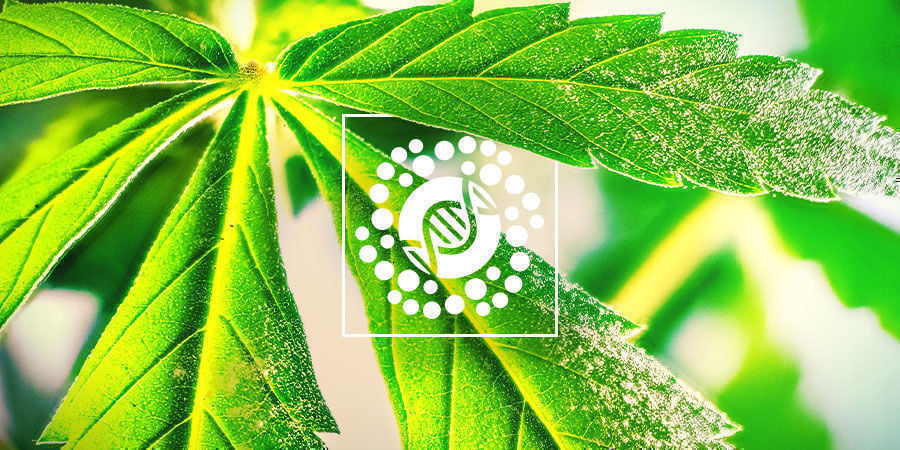
Are you looking for info on cannabis breeding, crossbreeding and pollen? If so, whether you're brand new to the task of cultivating cannabis, have plenty of experience, or are simply just looking for a deeper understanding, you have come to the right place. Allow us to guide you through everything you need to know, starting with pollen.
What is cannabis pollen?
Like many other plants, cannabis pollen is produced by the male plant and released to fertilise a female plant. Cannabis is dioecious, meaning it can produce both male and female plants. Cannabis pollen is characterised by having a fine powdery appearance that is a shade of pale yellow and is essential to the breeding process. Whether this is continuing a specified lineage or playing a part in crossbreeding to create hybrid strains, pollen's importance cannot be understated.
Sources of cannabis pollen
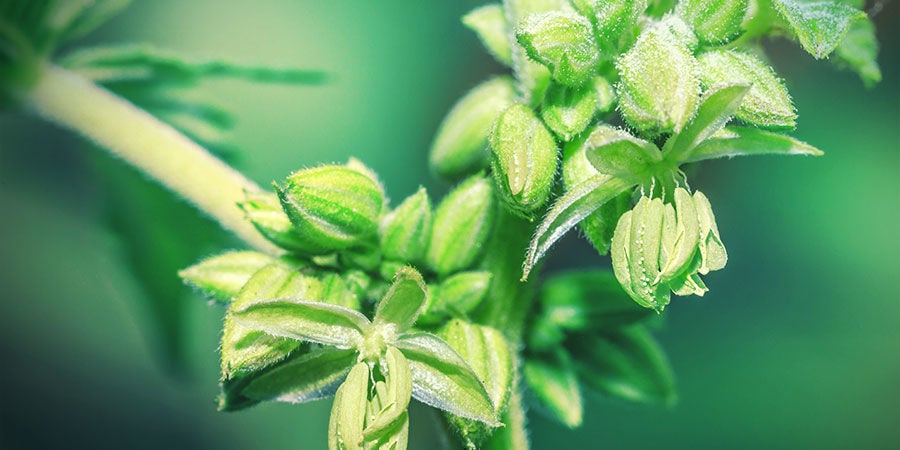
Cannabis pollen is usually sourced from male plants that contain XY chromosomes. Genetic male plants will naturally produce pollen to fertilise a female plant. The wind can carry the pollen in a natural setting until it reaches a female. In contrast, cannabis pollen can be collected from the plant in more controlled environments and used with a specifically chosen plant partner.
It is this collected pollen that can be used for selective cross-breeding.However, it's not just male plants that can produce pollen. Female cannabis plants with XX chromosomes can be manipulated through a series of processes to produce pollen. It is these techniques that allow for the production of feminized seeds.
Although these are the traditional methods for sourcing cannabis pollen, it is entirely possible to purchase readily extracted pollen ready to use. But this can be expensive to procure and quite tricky to find, depending on your location.
How to collect pollen for later use
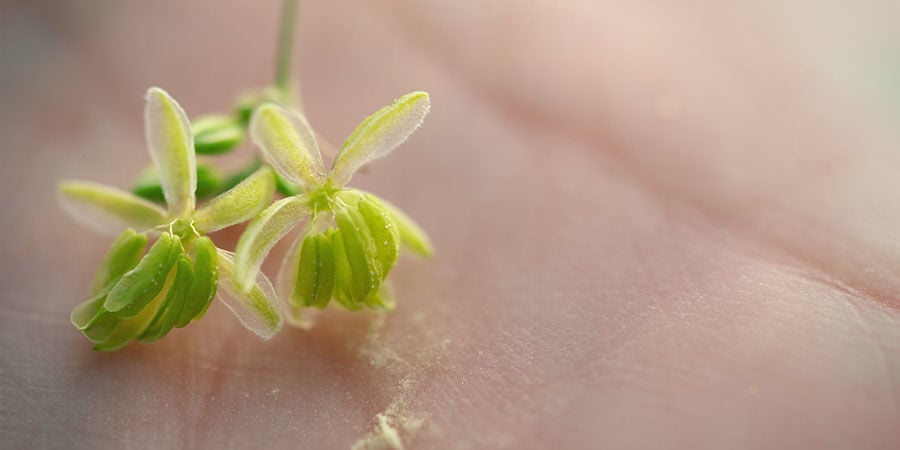
Collecting pollen is a delicate process and should be treated with due care and patience when undertaking. As male plants develop, growers will begin to notice the pollen sacs start to swell; this is a clear sign that they are pretty much ready to open up to spread their pollen. The production of pollen typically happens several weeks into the flowering cycle.
If looking to collect pollen from an indoor plant, make sure there is no breeze or electric fans near the plant. This will ensure that the precious pollen is not blown away by accident. Now you have the perfect collecting environment, it's time to collect the pollen.
There are a couple of different ways collection can be achieved, one method is waiting for the pollen sacs to open and pollen to fall onto the leaves. Once on the leaves, it can be dusted off onto a clean piece of paper and then collected. Another method is gently removing the pod from the plant and tapping it onto paper. After a gentle tap or two, you will see a nice neat pile of pollen ready to use.
As mentioned, it takes several weeks for the plant to prepare its pollen pod. However, those with plenty of cultivating experience may be able to precisely pinpoint the moment it's ready and squeeze the unopened pollen sacs, extracting the pollen. However, this requires expert timing as the pollen must be fully matured to be viable.
How to store pollen
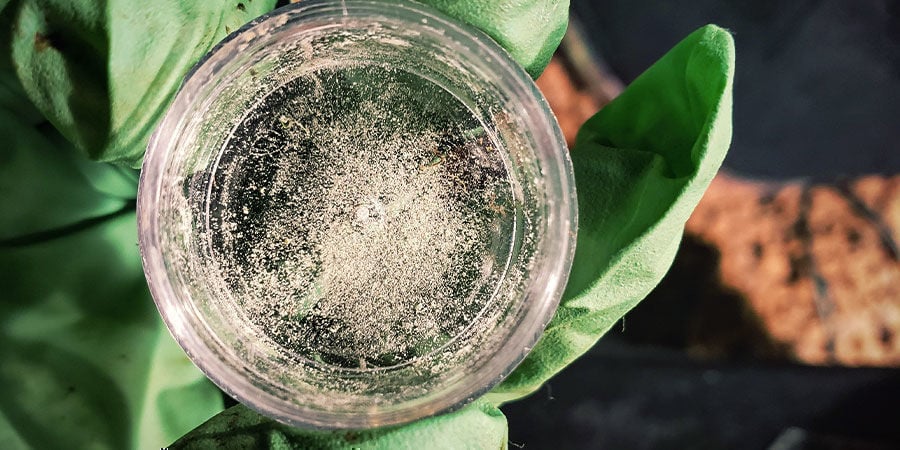
Now you have collected the pollen, you will need a suitable way to store it if you're not looking to use it immediately. Ideally, collected pollen should be kept in a cool, dark and, most importantly, dry environment. Moisture and humidity will be your worst enemies when it comes to successfully storing pollen. An area such as a pantry cupboard would almost certainly be your best port of call when it comes to location. Some even opt for using silica gel sachets to reduce the risk of any moisture impacting the pollen.
As a rule of thumb, pollen stored at room temperature, such as in a cupboard, will last roughly for 1-3 weeks. However, suppose you're looking to keep your pollen for a much longer period. In that case, it can be placed in a fridge or freezer for an extended amount of time. It can last up to 3 months in the fridge and as many as 12 in the freezer. Using silica gel in those instances is essential as these environments can produce moisture fairly easily.
Use a suitable container to store pollen
So you've got a place in mind to store your pollen, but what do you use to keep it in? Well, that's easy, simply use an airtight container. Some prefer to use ziplock bags, but for the safest and most secure options, it's definitely worth investing in a container that can lock tightly and can also keep the light out to avoid any impact on the precious pollen inside.
The connection between pollen and cannabis breeding
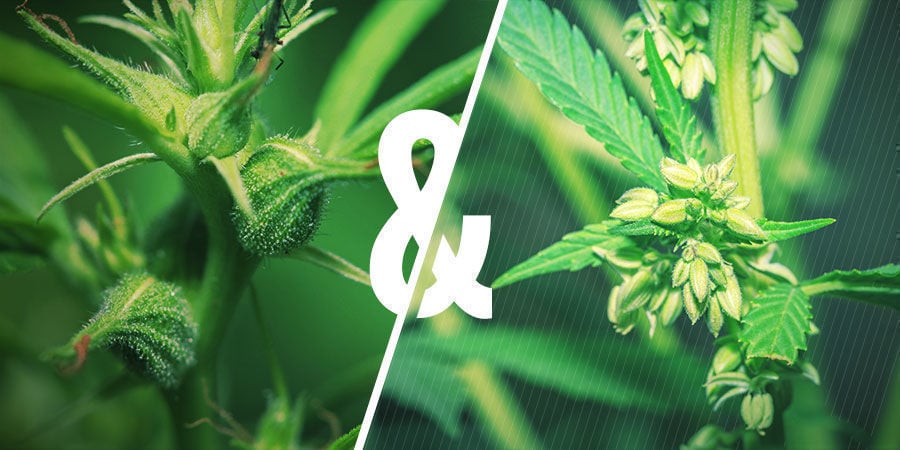
As we've touched upon, pollen can be utilised as a means to breed cannabis. Whereas in the wild, the use of pollen is really down to chance and location, in a more controlled setting, strains can be cross-bred with relative ease and with great success. But why is pollen such an essential element for cannabis breeding?
Essentially there are two main types of breeding. There is inbreeding, which is a process that involves both males and females of the same cannabis strain. The two cross, resulting in seeds that closely replicate the parent plants.
The other method of breeding is outbreeding. This involves crossing male and female plants of two different strains to create brand new hybrids. The use of outbreeding has resulted in finely tuned strains such as autoflowering variants that we know and use today. Combining different strains can result in a higher potency, varying effects and flavours, and different growth traits—just as examples of what's possible. However, it's also entirely possible to create some not so exciting combinations. More experienced and adventurous breeders will learn more about genetics and how to manipulate them to produce designer strains with specific characteristics.
It's fairly simple at its core when it comes to cannabis breeding and how pollen is used. All you need is a male and female plant and put them together in the same space as they're flowering to create seeds. As long as pollen is produced and a female plant is there to receive it, breeding can occur.
What to consider when breeding cannabis
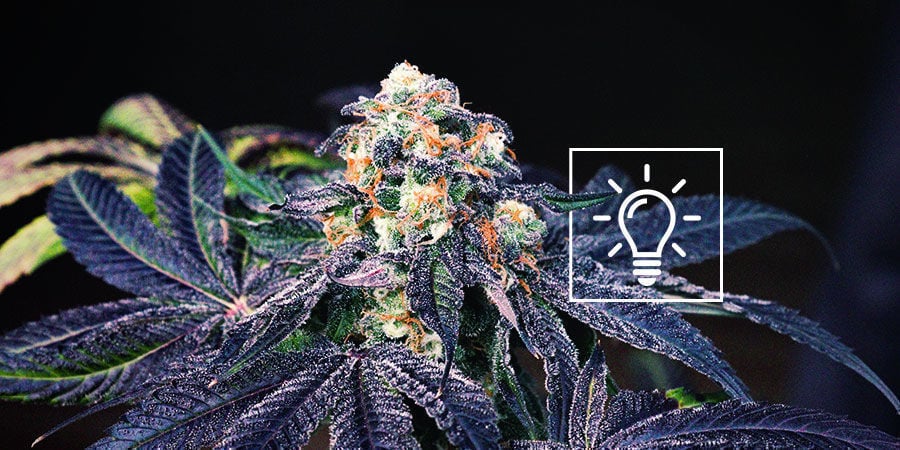
Of course, there are many areas to consider when breeding cannabis. This stems from which strains to choose, the traits to look out for, and understanding dominant and recessive cannabis genetics. With a combined grasp of all factors, you can produce some high-quality "homebrew" or "craft" cannabis from home. Let's look at each point individually and gain a common understanding.
Which strains to start breeding with
Arguably the most critical factor to consider: which strains should you start breeding with? As we know, you can cross virtually any two strains of cannabis, and, of course, you'll need both male and female plants to get started. But which strains should you start breeding with? While it might be tempting to opt for two strains you personally really enjoy, you may find yourself disappointed with their pairing.
Even if you cross two top strains, such as OG Kush and White Widow, for example, there's no guarantee that the next generation of plants will be any good. So take some careful consideration when picking your strains, and certainly don't be afraid to experiment. Who knows? Perhaps the most unlikely pairing of strains might be your most fruitful?
How to select the best phenotypes
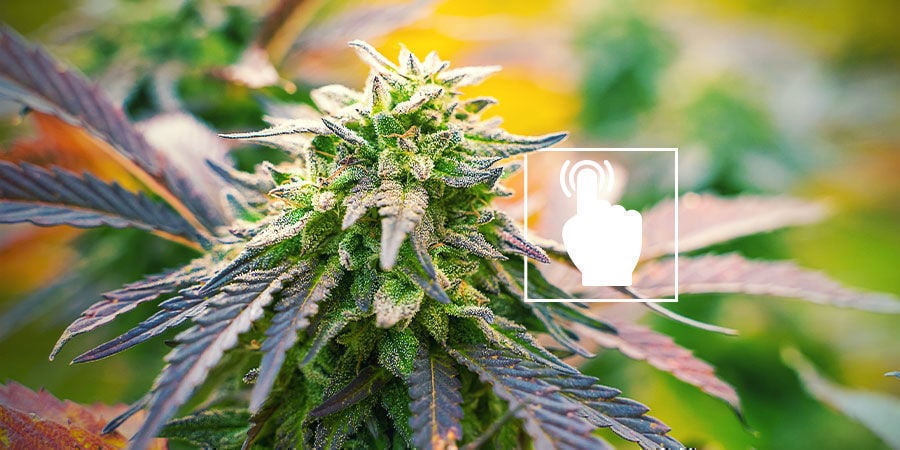
As soon as you bought and crossed your first batch of seeds, you'll end up with a new batch once the plant has flourished. These seeds take on different genetics despite coming from the same exact parent strains, and as a result, will grow into unique phenotypes—in the same way that two people can have multiple children, all of whom are different. But what should you look for in phenotypes?
Whether you do this in your spare time or are considering starting your own seedbank, your goal as a breeder is to identify desirable traits in your next generation of seeds and selectively breed them. It may sound like a tall order, but it really needn't be.
To do this, you'll first need to decide on which traits you want to continue breeding. This can be a multitude of various ones, such as yield, particular aromas, flowering time, colour, and resistance to pest and mould. It may take a little time to get familiar with your strains if you've new to the task, but as soon as you've cracked it, you'll instinctively know what you're on the lookout for.
Understanding dominant and recessive cannabis genetics
Whether a trait is dominant or recessive is relatively easy to work out. Dominant traits will be expressed more often across your cannabis offspring than recessive traits. To keep track of what traits are recessive and dominant over various generations of plants, it helps to use a Punnett square.
A Punnett square will make it very easy to see which genetic traits of your plants are dominant and recessive. Remember, even if a specific trait isn't passed down from your parent plants to the next generation of offspring, that doesn't mean the trait has now disappeared from the gene pool. It's still there but is likely just a recessive trait. However, if you continue breeding, you might find that trait coming out in future generations. As you gain experience, you will know if this is a good or bad thing for you.

What traits are worth breeding for?
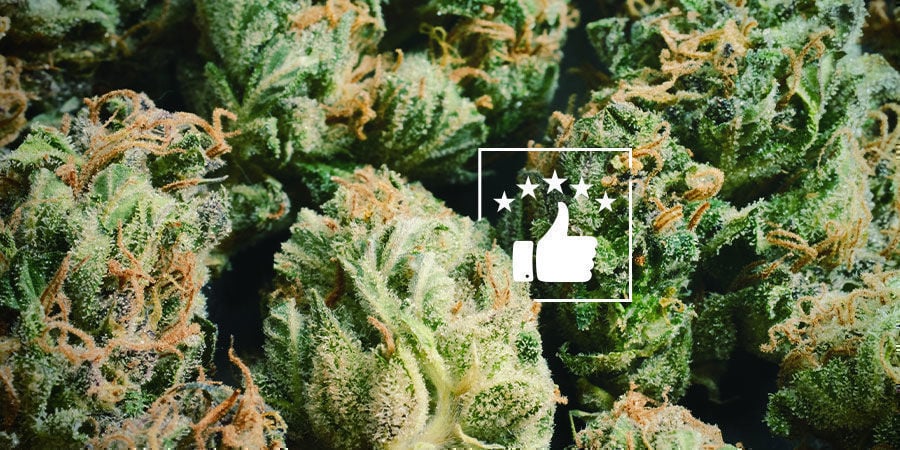
Of course, when it comes to which traits are worth breeding, it's really down to you and your preferences. However, there are some traits that, in general, are more prized by growers and breeders than others. So for a bit of inspiration, we've included some below that you may want to keep an eye out for.
-
Short flowering time
A short flowering time is highly favoured when it comes to breeding cannabis. Who wouldn't want to get their hands on some tasty buds sooner rather than later? In fact, strains with short flowering times(6-8 weeks) can be harvested up to 3 or 4 times a year indoors, providing growers with a steady flow of cannabis.
-
Small stature
Those looking for a more controlled, discreet growing project will undoubtedly opt for a smaller plant. Perfect for indoors, small cannabis plants are a godsend. In contrast, tall, stretchy sativas can be extremely hard to manage in tight spaces. So if you're a dedicated indoor grower, it's probably a good idea to breed smaller strains.
-
Autoflowering
When it comes to cultivating cannabis, we all want to take the easiest route. With very little maintenance required or any photoperiod changes to start flowering, autoflowering cannabis strains are a perfect project for all, regardless of experience. If you live in a region with short summers or are limited when it comes to space and money, breeding and growing autoflowers can be a great alternative.
-
Indica bud structure
Indicas naturally produce denser buds with more aesthetic appeal than their more loose, wispy sativa counterparts. If you want to produce the kind of bud you'd find on the shelves of a dispensary or coffee shop, consider breeding plants with indica genetics.
-
Colour
When it comes to cannabis, sometimes looks can be even more attractive than aromas and flavour, and nothing appears more interesting than a burst of colour on a plant. Cannabis plants can produce orange, red, or even purple buds in addition to the classic green. Look for these traits in your offspring, then pick and breed the ones you like most.
-
Flavour
Today's cannabis strains have been fortified with unique and delectable flavours courtesy of different terpene profiles. It's certainly a hugely popular trait to harness; you can use breeding to bring out specific aromas and flavour notes.
-
Yield
Who doesn't want large yielding plants? Choosing phenotypes with excellent production potential can boost the yield of subsequent generations of hybrids. Combine it with a fast flowering plant, and you could be working towards a lineage of lean, mean, wrecking machines!
-
Potency
This can be tricky to implement unless you have the instruments to measure THC and/or CBD content. Still, you can certainly select the most potent and/or balanced versions of a strain to feature the cannabinoid profile you most desire.
-
Pest and mould resistance
Some cannabis strains are naturally predisposed to repelling or resisting pests, mould, disease, and more. Selecting specific phenotypes for their hardiness and resilience can be especially advantageous for growers in less than ideal climates.
The types of cannabis breeding
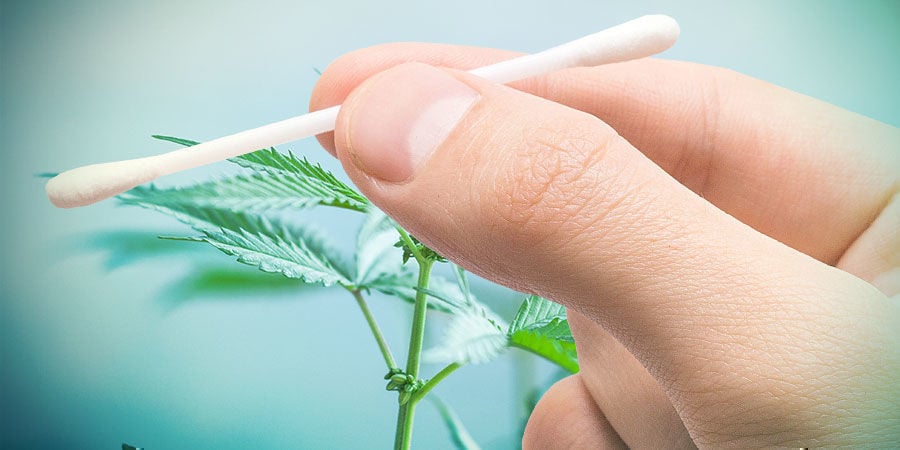
Now you've got a better idea about the traits you're looking to carry over into new generations of cannabis, it's time to look at the types of cannabis breeding and how to get the best out of a strain. Essentially there are three types of cannabis breeding; directional selection, compensatory mating and seed production. One by one, we'll break these down and show you what each one entails.
Directional selection
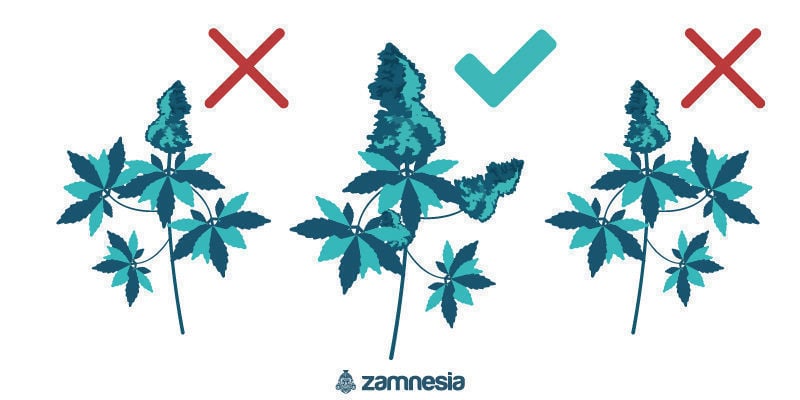
Directional selection specifically targets a trait and acts to preserve it to reproduce it. For example, if you are keen on a specific flavour profile, the use of directional selection breeding would let you identify the exact phenotype. You can then use this phenotype to produce a strain with that particular terpene profile. It's essentially a means of negative natural selection (the selective removal of unwanted specimens), allowing growers to tailor strains to their exact specifications and liking.
Compensatory mating
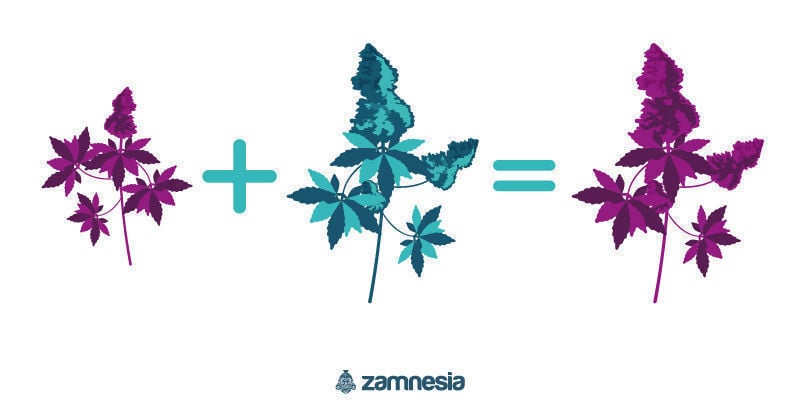
This is a method of cannabis breeding that allows growers to take the best traits from two separate plants to produce a brand new strain. This new strain ideally makes up for any defects or limitations from the parents. For example, this could be combining two strains where one is tall and sparse, and the other is short but bushy. The result is a plant that would take the strongest traits of both to produce a strain that would be perhaps limited in height but would have much better placement of where the buds would grow. Of course, the results could be varied, so some fine-tuning and generations of breeding is undoubtedly required.
Seed production
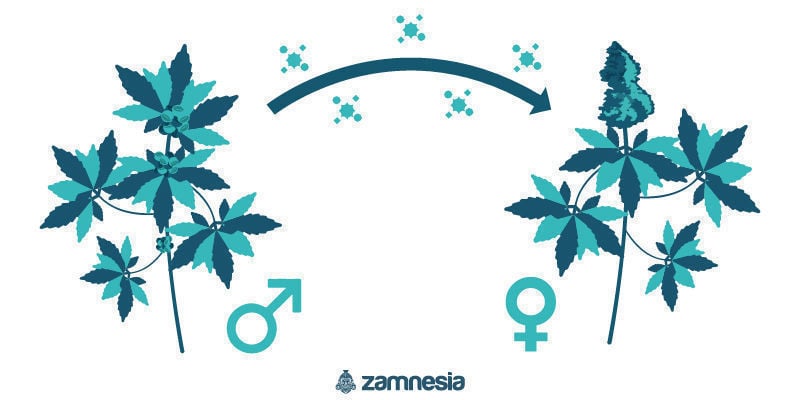
While not necessarily recognised as a true means of breeding, seed production, or "pollen chucking", is essentially the practice of plying female plants with a gathering of pollen. Similar to how it would naturally happen, the pollen then interacts with the female plant to produce seeds. While the other breeding techniques focus a little more on selecting traits, seed production is only really used for that purpose—making seeds, any seeds.
How to use pollen to breed cannabis
Pollen collected from a male or reversed female plant can be used to breed cannabis. As mentioned previously, this can be achieved through the practice of inbreeding and outbreeding. Suppose you've collected and stored pollen from a plant. In that case, you can always look to the process of seed production and apply the pollen directly onto a female plant. However, you can place a male and female plant in close proximity and either create a pollinating tent that uses a system of fans to simulate a more natural, outdoor environment for the pollen to be carried over to the neighbouring plant, or you can look to rub the pollen dusted leaves of the male over the exposed pistils of the female plant.
Regardless of which method you choose, the actual physical work of breeding plants is a relatively simple one and is really down to timing. Many growers will wait until around 24 days into the plant's flowering cycle before looking to pollinate.
Plan your pollination and breeding today
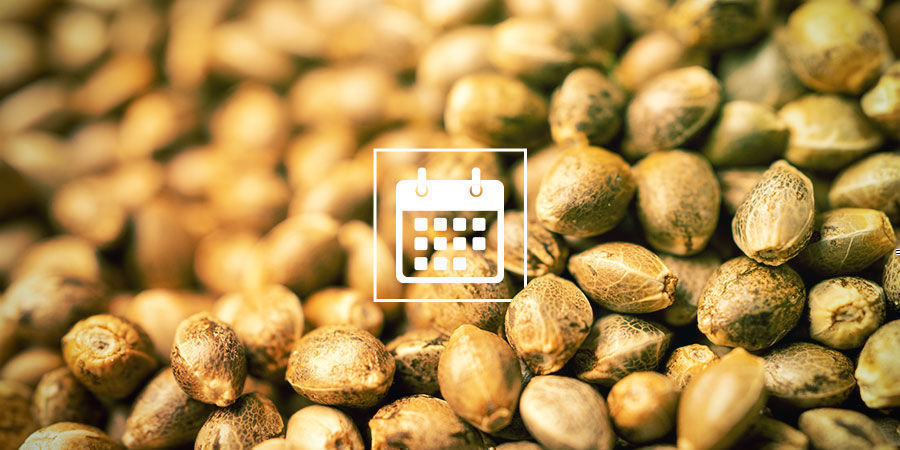
There is our breakdown of everything you need to know about the use of pollen and the various forms of cannabis breeding. It may seem like a lot to digest at first, especially if your growing experience isn't vast. However, don't let it put you off. It really is down to practice, trial and error, and overall, learning as you go. Don't be afraid to make mistakes when it comes to producing strains of cannabis, and you'll find that your experience and confidence will grow over time.








 United States
United States













